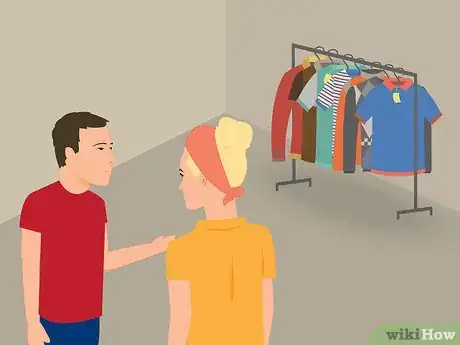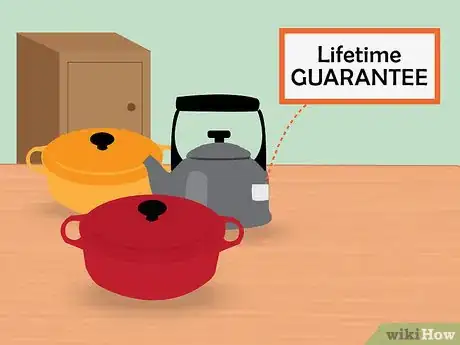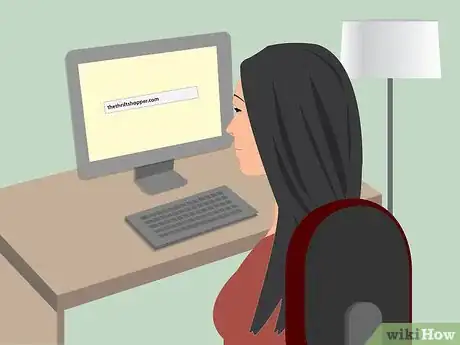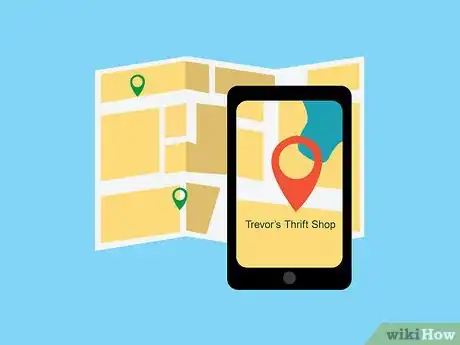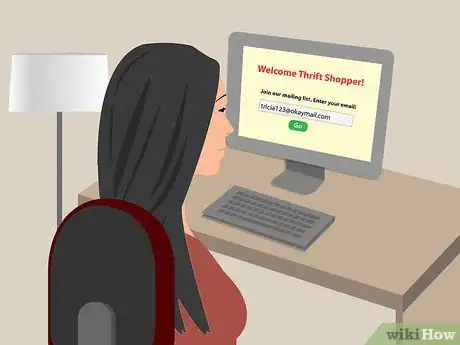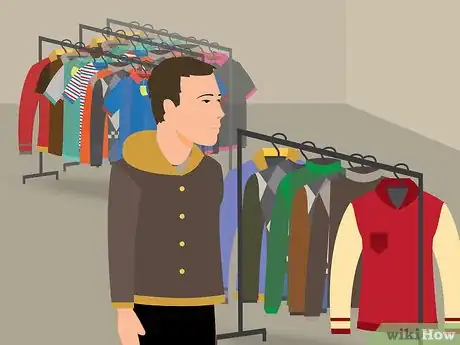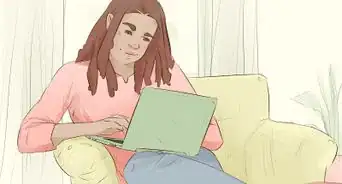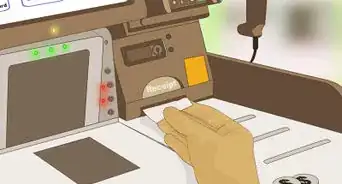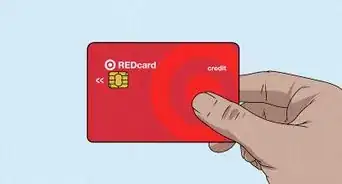This article was co-authored by Dina Scherer. Dina Scherer is an Image and Wardrobe Stylist and the Founder of Modnitsa Styling, based in New York City. With over a decade of experience, Dina specializes in color analysis, style development, closet editing, and personal shopping. She helps her clients elevate their personal style and curate a wardrobe aligned with their lifestyle. Dina holds degrees in Advertising and Marketing, Fashion Merchandising, and a Certificate in Image Consulting from the Fashion Institute of Technology.
There are 10 references cited in this article, which can be found at the bottom of the page.
wikiHow marks an article as reader-approved once it receives enough positive feedback. In this case, 100% of readers who voted found the article helpful, earning it our reader-approved status.
This article has been viewed 348,431 times.
Thrifting is a fun and responsible way to make the most from your shopping money. Not only can thrifting provide unique, rare, and vintage accessories for your wardrobe and home, it is a form of recycling that reduces environmental waste and sweatshop labor. Make the most of your thrifting trips by learning how, where, and when to do your shopping.
Steps
Shopping at Thrift Stores
-
1Decide what you are looking for. Listing is a handy way of establishing shopping goals. Also consider the following:[1]
- It is often best to have a "master list" and then create a smaller list of short term goals that need to be addressed first.
- Some flexibility should be in your list. You may not be able to find a pink silk organza dress in size 16, for example--that may be too exacting to be handled by thrifting. But you may be able to find a nice dress in size 16 for your stepsister's graduation if you search well enough.
- Be prepared to search for your needs. Some thrift stores are well-organized by gender, size, type of item, or other metrics such as color. Others are a free-for-all of bins and warehouse space.
- Prior to thrifting, thoroughly examine your closet and do an inventory of it. Note down which pieces you might have not worn yet that month. Through this, you can become inspired to find a particular item to match the clothing and finally wear it! You can also prevent buying clothing similar to what you already have.
-
2Try things on. Without trying clothing on, it is difficult to tell whether it is worth your money.[2]
- Ask for a fitting room with a mirror or a convenient restroom.
- Dress in form-fitting attire in case a fitting room is not available. That way you can try on clothing over your existing clothes. Leggings and sports bras can be useful in this.
- To eyeball if a garment will fit around your waist without trying it on: button it, and then wrap it around yourself from bellybutton to spine.
Advertisement -
3Assess quality. Thrift store items are typically purchased "as is"; therefore, it is important to look all purchases over thoroughly before committing to a purchase. Some things to look for are:[3]
- If looking at clothing, check seams, cuffs and collars for wear and damage. A button might be a simple fix, but that may not be the case with a ripped-out seam.
- Look for staining, especially around the neck, armpit, and inseam.
- Dirt, lint, and animal hair can often be laundered, but there are no guarantees.
- For furniture, make sure that it is sturdy and does not require repairs you are unable to perform.
- For appliances, ask to plug the item in to make sure it works before purchasing.
- Check the washing instructions. Getting a silk shirt for $3 initially looks like a great deal; however, when you consider that it's "dry clean only," the savings aren't nearly so great.
-
4Have vision. Part of thrift shopping is having a basic idea in mind but being open to opportunities when you find them. Consider the following:
- Recognize when a clothing item could be repaired or resized with minimal tailoring.
- Have a style and color scheme in mind for each room you are decorating. This ensures consistency of theme and avoids impulse purchases.
- Listen to your gut. Sometimes you may come across an item that you weren't looking for but which is unique, classic, and perfect for a place in your home.
-
5Set shopping limits. You never know what you'll find thrift shopping and the temptation to impulse buy is strong. Ways to avoid over-purchasing are:[4]
- Go shopping with a price limit in mind and stick to it. This may be a limit you set per item, or for the overall trip, but the idea is to remain mindful of how much you are spending.
- Don't buy it unless you really love it. Just because it is inexpensive does not necessarily mean it is for you.
- Would you buy the item if it were full-priced? Buy that designer jacket that you could not afford at the mall. Ditto for the jeans that might be a bit worn, but you really like that look. But do you really need that shirt that you kind of like but is cheap? Probably not.
- If you are on the fence about something, take another spin around the store and think about it. If you come back and aren't committed, it wasn't meant to be.
Thrifting Tips and Tricks
-
1Use your smartphone. This works great for vintage or antique items when you are not sure an item is worth the price listed. Go to Google or eBay and see what it would retail for elsewhere.[5]
-
2Shop for sales. Many stores have weekly "tag sales," where items with a certain color tag go on sale. Other stores have clearance racks or do periodic sales to clear out inventory. Some larger volume stores even do bag sales and sales by the pound for items like clothes and linens.[6]
- Don't be afraid to haggle. Did you just miss a sale on a large item purchase? Are you making multiple purchases and want to round off the total? Don't be afraid to ask for reasonable accommodation, especially if you are a regular customer.
- Don't believe the "SOLD" sign. Sometimes the item is already paid for; however, often people say they will come back for something then find something else they like better at a different store. If you see something you love with a sold sign, talk to an employee and/or manager. It's possible the item has been sitting like that for days and no one remembered to remove the sign.
- Ask for a discount. Does the item in question have a few flaws that are worth a discount? Is the store running a sale that day? If you are buying sale items, often employees can extend the sale to the rest of the items in your purchase. Some stores also have senior discounts.
-
3Look for "best value" items. Some types show up in thrift shops looking kind worn out or dated. Other items are donated regularly and you'd never know they were used or second-hand. Look particularly for the items below:[7]
- Belts: Accessories like belts are one of the first items to get decommissioned from a wardrobe when styles change. An advantage to belts is that, with a little creativity, the buckles can be replaced and a strip of plain leather doesn't really go out of style.
- Shoes: Decent leather shoes command steep prices in most retail stores, so when you can pick up gently used ones at a thrift store for 90% less, it's a significant savings for your budget. Plus with a little oil and polish, they can look brand new. [8]
- Furniture: Sometimes retail stores will donate last season's merchandise to area thrift stores for tax purposes. In addition, vintage furniture can be recovered, repainted, or reupholstered with new fabric to look like a chic DIY dream.[9]
- Jeans: New branded jeans can run from $50 to upwards of $200 dollars while shopping for next-to-new, second-hand jeans usually means paying $10-25 a pair. Especially after Christmas, it's easy to find them with tags still intact.
-
4Talk to thrift store employees. The people who work in thrift stores are a wealth of information. Things to ask about are:
- What days do shipments arrive? Employees can tell you what days they get new items in and when things go on sale.
- Who are they partnered with? They can tell you whether their store has a donation program with a larger retail store where they take possession of clearance items from a prior season.
- Have you seen a particular item? If you are a regular customer and make donations, thrift stores will often let you know via phone or email when a specific item you are looking for comes in.
-
5Know how to spot a bargain. People often send items to thrift stores not knowing their actual value. Consider the following when thrift shopping:
- Brand warranties: Some appliances and kitchen tools have lifetime warranties. For example, Le Creuset cookware is ensured against rust along with other cosmetic issues. Proof of purchase is not required to send an item back to the factory and receive a replacement, free of charge.
- Antiques and hidden treasures. Despite wear and condition, items often go to thrift stores that are invaluable, based on their rarity and place within history. If you suspect you've found such an antique, use a smart phone to look for it online and see the price tag other sellers have placed on it.
- Tarnish. Tarnished metals looks terrible, but are often easy to shine up with the right polish.
-
6Bring a friend. Two pairs of eyes is always better than one. Not only is it more fun to thrift with a friend, they can also help provide important feedback and recommendations—and you can do the same for them! It's a win-win situation.
Finding Thrift Stores
-
1Search online. Many thrift stores have websites that will show up in a basic search. Also consider using thethriftshopper.com to find smaller, independent stores along with larger stores in your area.
-
2Consider location. The types of residents living around a thrift store can be a good indicator of the sort of items and level of quality you can expect from a thrift store. For example:[10]
- Thrift stores in more affluent neighborhoods have better quality furnishings than thrift stores in other parts of town. Also, residents in affluent areas are more likely to redecorate based on style rather than necessity, meaning that it can be easier to find matching items of good quality.
- Thrift stores near college campuses are always stocking name brand clothing.
-
3Thrift on vacation if possible. This works best when vacationing with a car. Especially if you are visiting a large city, larger volume thrift stores tend to offer a wider selection of items, often of better quality. There's also the chance that trends in the area you are visiting are different than where you are from, and you could find unique and eclectic items.[11]
-
4Utilize other discount shopping venues. Thrift stores are not the only source of bargain shopping.
- Flea markets. Show up early— 6am is a good start. Do a sweep for furniture items first, picking and choosing what you want. Don't be afraid to haggle, but be fair to the seller. Once you've found furniture and larger items, load them and look for smaller items-- furniture, accessories, clothing, etc.[12]
- Consignment stores. These are a type of second-hand store that purchases clothing from sellers as opposed to selling donations. This makes them more expensive than thrift stores, but they are a dependable source of well-made, discounted, name brand clothing that is in fashion at the time of purchase.
- Neighborhood yard sales. While yard sales occur in every city almost every weekend, in order to maximize shopping and save time, look for neighborhood yard sales. These often take place in a single location, like a church or school, or span several blocks, with people selling from their own yards. These are a great way to find furniture and antiques.
- Estate sales. The ultimate source for gently used antiques, ranging from furniture and dishes, to jewelry and quilts. These take place literally on the "estate" where a person lived and require a little more foreknowledge and research in order to get the best deals.[13]
Creating a Thrifting Schedule
-
1Get on email lists and shop online when possible. Most chain thrift outlets like Goodwill and the Salvation Army will put you on a mailing list for coupon and sale opportunities.
- These same stores often take pictures of furniture and other "in demand" items and post them online. Reviewing online offerings before shopping can save you trips around town.
-
2Shop seasonally. Anticipate what people will be turning out of their closets at certain times during the year. When planning your thrifting trips, for certain items, consider the following:
- Shop for summer clothes in the fall when people are thinning out their warm weather clothes in favor of sweaters and coats. The same goes for getting winter clothes in the spring.
- Look for kitchen items and accessories after college graduations. When students are done with school, they often move back home or to a new city for employment, leaving behind many gently-used kitchen items, lamps, bedding items, etc.
- Look for furniture during the summer and early fall. More people get married during the summer than any other time of year and often have duplicate furniture items that wind up at thrift stores.
-
3Have a weekly rotation. Looking to get the best deals that thrifting has to offer? Create a weekly rotation for thrifting, centered around when new shipments arrive at each store. Other things to consider are:
- Shop early. If you want to get first pick, arrive as the store opens.
- Shop late. On sale days, some stores are looking to clear out all items on sale, and will offer deeper discounts just before closing.
Expert Q&A
-
QuestionWhat should you wear to go thrifting?
 Dina SchererDina Scherer is an Image and Wardrobe Stylist and the Founder of Modnitsa Styling, based in New York City. With over a decade of experience, Dina specializes in color analysis, style development, closet editing, and personal shopping. She helps her clients elevate their personal style and curate a wardrobe aligned with their lifestyle. Dina holds degrees in Advertising and Marketing, Fashion Merchandising, and a Certificate in Image Consulting from the Fashion Institute of Technology.
Dina SchererDina Scherer is an Image and Wardrobe Stylist and the Founder of Modnitsa Styling, based in New York City. With over a decade of experience, Dina specializes in color analysis, style development, closet editing, and personal shopping. She helps her clients elevate their personal style and curate a wardrobe aligned with their lifestyle. Dina holds degrees in Advertising and Marketing, Fashion Merchandising, and a Certificate in Image Consulting from the Fashion Institute of Technology.
Wardrobe Stylist & Personal Shopper Wear comfortable shoes because you're going to do a lot of walking. However, make sure that you are bringing a pair of shoes that you're going to be coordinating with these looks. Also, undergarments are often overlooked. If you're not wearing the right bra or bra that's very supportive, you're going to see that through the clothes and that's again going to impact the look of the outfit.
Wear comfortable shoes because you're going to do a lot of walking. However, make sure that you are bringing a pair of shoes that you're going to be coordinating with these looks. Also, undergarments are often overlooked. If you're not wearing the right bra or bra that's very supportive, you're going to see that through the clothes and that's again going to impact the look of the outfit. -
QuestionI'm scared of germs on stuff at the thrift store. How can I cope with this?
 Community AnswerThink about it this way. There are germs at the high end shopping centers or malls too because shoppers are constantly touching things, trying things on and putting them back on the rack, etc. The clothes are new, but not really new. You should wash everything before wearing, regardless of where it comes from.
Community AnswerThink about it this way. There are germs at the high end shopping centers or malls too because shoppers are constantly touching things, trying things on and putting them back on the rack, etc. The clothes are new, but not really new. You should wash everything before wearing, regardless of where it comes from. -
QuestionCan a thrift store be a go-to place to do my shopping for my man cave?
 Community AnswerOf course it can! In a thrift store, you never know what you will find. It's an exciting place to shop.
Community AnswerOf course it can! In a thrift store, you never know what you will find. It's an exciting place to shop.
Warnings
- Wash, then wear. Thrift stores are not required to wash clothing before it goes on the rack. It may have been sitting in someone's garage or attic or even outside before it was donated. Wash or dry clean all linens, clothing and blankets before use. This ensures health and safety against illness.⧼thumbs_response⧽
- Avoid personal products. Be careful purchasing undergarments or body products at thrift stores. Also remember that makeup items, even if sealed, have an expiration date. Cream blushes and foundation, depending on age, can go rancid without being opened. Never purchase items that are already open, as makeup can cause and/or spread infections.[14]⧼thumbs_response⧽
References
- ↑ http://www.huffingtonpost.ca/2013/10/16/thrift-store-shopping-tips_n_4108664.html
- ↑ http://money.usnews.com/money/the-frugal-shopper/2014/03/06/9-thrift-store-tips-and-tricks
- ↑ http://money.usnews.com/money/the-frugal-shopper/2014/03/06/9-thrift-store-tips-and-tricks
- ↑ http://www.huffingtonpost.ca/2013/10/16/thrift-store-shopping-tips_n_4108664.html
- ↑ http://www.huffingtonpost.ca/2013/10/16/thrift-store-shopping-tips_n_4108664.html
- ↑ http://www.amazinggoodwill.com/events-and-promotions/topic/goodwill-color-tag-sale
- ↑ http://www.wisebread.com/the-5-best-deals-in-every-thrift-store
- ↑ http://www.curiousnut.com/make-old-leather-shoes-new/
- ↑ http://www.houzz.com/ideabooks/13402865/list/budget-decorator-8-ways-to-make-old-furniture-look-brand-new
- ↑ http://money.usnews.com/money/the-frugal-shopper/2014/03/06/9-thrift-store-tips-and-tricks
- ↑ http://www.livelovediy.com/2014/01/10-thrift-store-shopping-secrets-you.html
- ↑ http://stylebyemilyhenderson.com/blog/15-flea-market-secrets-how-i-find-the-best-vintage-pieces
- ↑ http://www.ebay.com/gds/How-To-Find-Great-Things-for-Resale-at-Estate-Sales-/10000000002805868/g.html
- ↑ https://www.urmc.rochester.edu/encyclopedia/content.aspx?ContentTypeID=1&ContentID=724
About This Article
To shop at a thrift store, make a list of the general items that you're looking for, like shirts, jeans, purses, or shoes, and visit a few stores near you. In the store, pick the clothes that you like, and try them on to make sure they fit properly. Inspect the item to make sure there are no frayed seams or holes in the fabric, but be open to items that you can get at a discount and repair. Be on the lookout for sales and ask employees about new inventory to get the best deals! For tips and tricks for shopping at thrift stores, keep reading!








